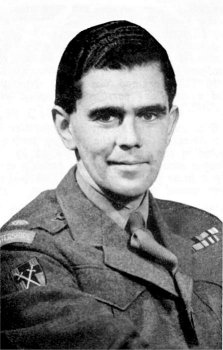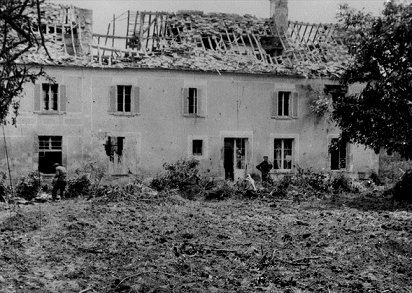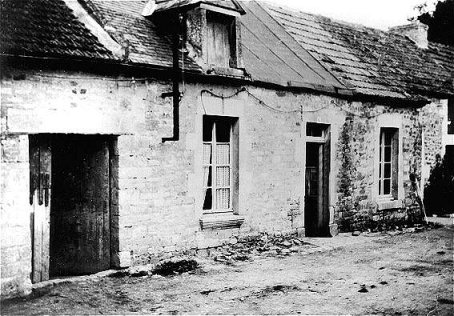Lieut. Peter Geoffrey Hall (148942)
(15 Platoon, ‘C’ Company)
In Normandy, Peter Hall was a platoon commander with ‘C’ Company and was
unlucky to be wounded in the arm and shoulder during the battalions first
action at Mouen.

Lieut. Peter Hall, D.S.O.
(later Lieut.-Colonel)
He was evacuated to England on the 29th June 1944. After hospital treatment
he rejoined the battalion and ‘C’ Company at Pressagny L’Orgueilieux on the
7th September 1944. During the battle at Elst he accidently fell through a
trap door in a barn at Valburg (22/09/1944) and was evacuated to ‘A’ Echelon
at Nijmegen for 24 hours rest. In December 1944 he temporary commanded ‘D’
Company at Bilsen, Belgium, whilst Major Bryan Elder was on leave. As
T/Captain he was 2 i/c of ‘B’ Company during the Goch escarpment action.
In March 1945 he commanded ‘A’ Company as A/Major during the Autobahn attack
at Vehlingen, where he was recommended for a Military Cross (M.C.). He
continued to command ‘A’ Company and was awarded the Distinguished Service
Order (D.S.O.) for his actions during the battle at Ahlhorn crossroads.
Peter was wounded for a second time on the 16th April 1945 as a result of a
land mine which blew up a carrier in front of him, this time he received an
eye wound.
Below is Peter’s story in his own words;
The plan was that the Worcestershires should attack Mouen by daylight -
but under cover of an intense artillery smoke screen, mixed with artillery
high explosive fire on located forward enemy positions in the hedgerows just
west of the village.
From the start line to our first objective we had to move for about 800
yards through a cornfield that afforded little or no cover from enemy small
arms fire and machine guns. These enemy positions were situated on a small
ridge - dominating our line of advance.
Without the smoke - or without the cover of darkness - our assault troops
would have been mown down, incurring horrendous casualties.
My Company Commander (the late Major Johnny Gutch M.C.) and I discussed our tactics for this attack. We agreed that we should keep as close behind the artillery barrage as possible - perhaps risking casualties from our own guns. The advantage could be that we would descend upon the enemy whilst they were still stunned by the weight of artillery shells which had descended upon them.
This tactic paid off handsomely. The only casualty which we had in my platoon was me! Suddenly there was an almighty crash - about 20 yards to my left. I felt a great smack on my left arm, buttock and shoulder. It was rather like the experience I had frequently had on a pre-war hockey field. A big wham. And, then, no pain.

Having been through the enemy front line, I judged it necessary that my platoon should exploit for about another 100 yards beyond our initial objective. This to enable the two reserve platoons of the Company to advance further into Mouen -supported by a solid firm base - for us.
This plan necessitated my platoon’s occupation of a derelict farmhouse on the reverse slope of the original German position. Occupation of this building would give covering fire for my Company Commander to deploy his two remaining platoons down the reverse slope to secure the total Company’s objective.
I, with one of my sections in support, cautiously investigated this farmhouse. We found a most pathetic sight which I shall never forget - or can ever explain.
Some moments later.... two things happened. ONE - my Company Commander arrived on the scene. TWO - the enemy reacted with heavy artillery and mortar fire. We both dived for cover in a German slit trench. One on top of the other.
What I think happened next was that my Company Commander looked at my left arm and said, “Peter, your left side is a bloody mess. I’ll get you evacuated!”

The Farmhouse at Mouen after the attack (June 1944)
I then passed out.
I cannot recall what happened after that. Except that I, eventually, found myself in a hospital ‘somewhere in Surrey’. Leaving my comrades to get on with the war without me.

The house at Baron (near Mouen) which was used as the Battalions R.A.P.
(where Peter Hall was initialled treated for his wounds)
After a short leave, I was ordered to report to a transit camp at Cowley Barracks, Oxford. Here I was told by the Commandant that my duties were to tour the munitions factories and tell the lady workers how much we, the fighting troops, appreciated their great efforts. This we truly did.
This was a doddle of an assignment. I was given the use of an army car, with driver, and an itinerary of factories in the Midlands.
My assignments consisted of ten-minute talks to the ladies at lunchtime. I told them how marvellous they were and how we depended on their wonderful work. I really meant that.
After the first week I distinctly remember one motherly munitions worker saying to another, “Poor boy! He looks so wan and frail! He must have been through hell!”
I had! But it was the hell of too much hospitality.
It was, undoubtedly, my salvation that I was returned to the war of shot and shell in N.W. Europe.
Footnote: Colonel Peter Hall, D.S.O. died at home at Ashurst Wood, Sussex on the 21st October 2005, age 86.